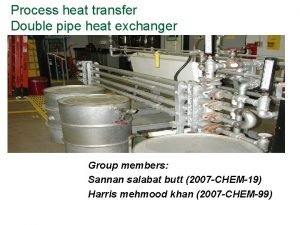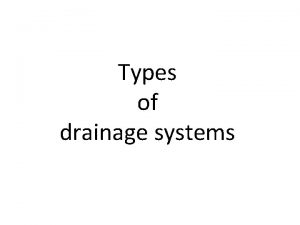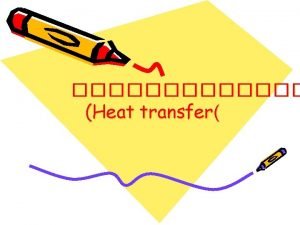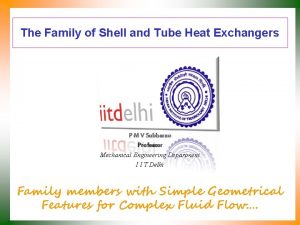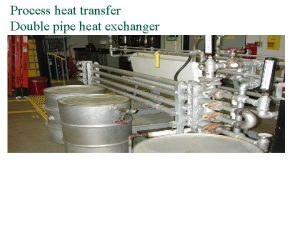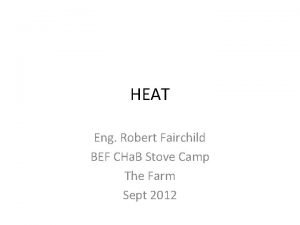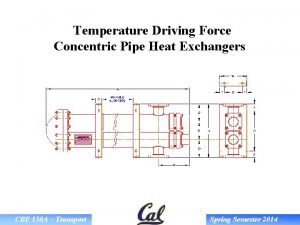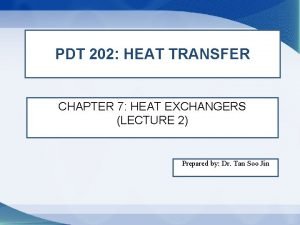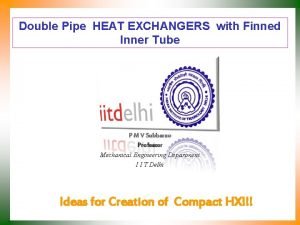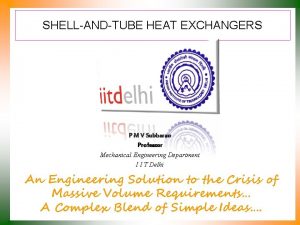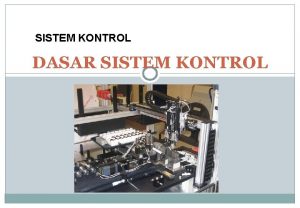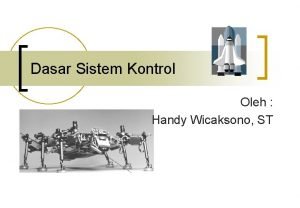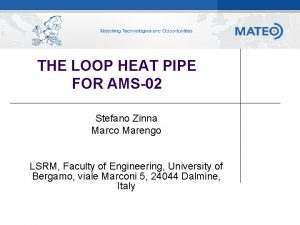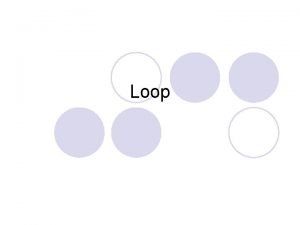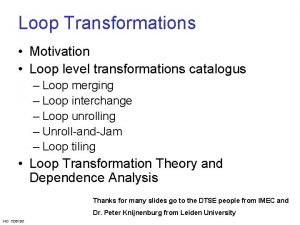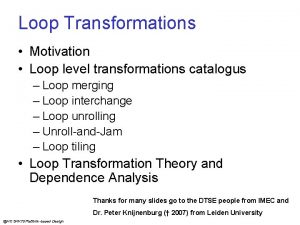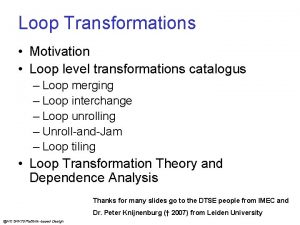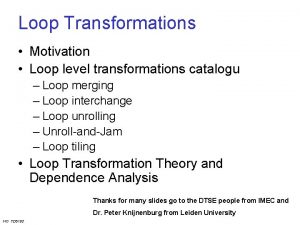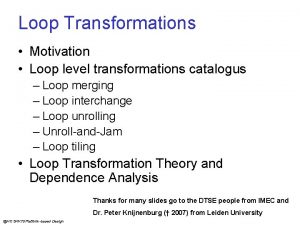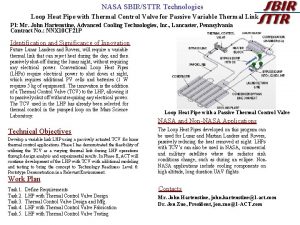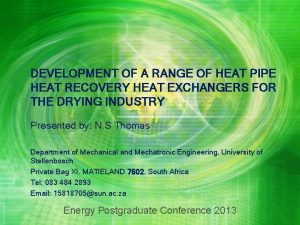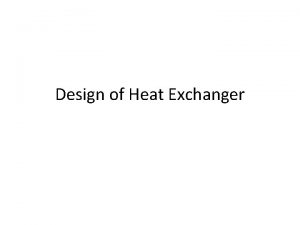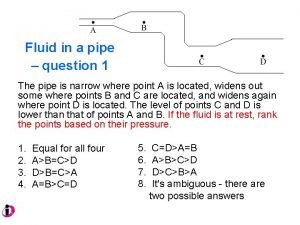THE LOOP HEAT PIPE FOR AMS02 Stefano Zinna






















- Slides: 22

THE LOOP HEAT PIPE FOR AMS-02 Stefano Zinna Marco Marengo LSRM, Faculty of Engineering, University of Bergamo, viale Marconi 5, 24044 Dalmine, Italy

Inside ANTASME (I) UNIBG is involved in the WP 8 and 9. A collaboration with TUE is defined in order to obtain physical models from the FEM analysis for the lumped capacitance simulation of a propylene by-pass valve The construction of thermal chamber in China is delayed and at the present conditions is likely that the comparison of the ground model simulation with experiments (i. e. the WP 8. 3) will not be carried out

Inside ANTASME (II) OBTAINED RESULTS A Loop Heat Pipe model was built with the following mesh characteristics: The pipe is divided in 93 thermal nodes: 15 in the vapour line (1 temperaturevarying capacitances), 13 in the liquid line (1) and 65 in the condenser line (1). The radiator is divided in 176 thermal nodes having temperature-varying capacitances. The evaporator is constituted by 5 capacitance nodes. The fluid line has 93 fluid nodes. The evaporator 3 fluid nodes (reservoir, wick & grooves). The physical model included: SINGLEPHASE and TWO-PHASE regimes. The heat transfer coefficient in microgravity is 50% less than the correspondent in normal gravity when the flow pattern is bubbly or slug. In that case a parameter that cut 50% heat transfer coefficient’s value can be imposed. The orbital simulations were then obtained for the worst conditions: a) Hottest boundary conditions and maximum power to reject; b) Coldest boundary conditions and minimum power

INDEX l l l l l AMS-PROJECT AMS-THERMAL CONTROL CRYO-COOLER AMS-LHP LHP-COMPONENTS SINDA/FLUINT LHP- NUMERICAL MODELITATION SINGLE PHASE FLOW TWO PHASE FLOW FRICTIONAL PRESSURE DROP CORRELATION TWO PHASE FLOW HEAT TRANSFER COEFFICIENT Wick- PHYSICAL MODELITATION BOUNDARY CONDITIONS 21 CASES NOMINAL CASES WORST CASES By-pass Passive valve LHP (propylene based) complete assembly LHP-VALVE

AMS-PROJECT l l The Alpha Magnetic Spectrometer is a space born detector for cosmic rays built by an international collaboration. AMS will operate aboard the truss of the International Space Station (ISS) for at least 3 years (2008? ) The central tracker is the core of AMS -02, both conceptually and geometrically. It measures trajectories of particles in a magnetic field provided by the superconducting magnet.

AMS-THERMAL CONTROL l l l Since the magnet is a lot colder than the ambient environment of the Space Station, it has to be cooled actively. The principal coolant is a volume of superfluid helium in a tank kept in indirect thermal contact with the magnet The heat is transferred into the main helium tank, where it is consumed by boiling superfluid helium. Ultimately, heat is removed from there by venting this induced helium vapor into space Since the amount of helium is limited, this can become the limiting factor that finally determines the end of the experiment at large. To avoid that as long as possible AMS-02 is equipped with 4 cryo coolers — heat pumps based on the principle of the Stirling cycle of classical thermodynamics.

CRYO-COOLER l l Conceptually, cryo-cooler remove heat energy at what is called their “cold tip”, and transfer it forcibly to a warmer body thermally connected to their other end: the “sink”. The pumps are operated under some conditions about their temperature Minimum (+heat lift) 60+3 W / cryo-cooler Maximum (+heat lift) 150+8 W / cryo-cooler Nominal (+heat lift) 100+5 W / cryo-cooler Min. turn-on and operational temperature of the Cryo-cooler -10°C Max. operational temperature of the Cryo-cooler +40°C Min. non-operational and survival temperature of the Cryo-cooler -40°C Max. non-operational and survival temperature +40°C

AMS-LHP l l Loop Heat Pipes (LHP) are robust, self-starting, passive two-phase thermal transfer devices. Therefore the LHP is the link between the Cryo -cooler and the radiator. The power is dissipated by the radiative heat transfer towards external environment (zenith radiator) ZENITH RADIATOR A M S 0 2 CRYOCOOLER l l Every cryo-cooler is connected to two LHPs (redundant). Working mode: 2 -LHP model (nominal way) 1 -LHP model (failure way) Every LHP transfers the power towards a quarter of the zenith radiator

LHP-COMPONENTS Power (CRYO-COOLER) Compensation Chamber (reservoir) Vapour Liquid line SOLAR FLUXES AMBIENT

SINDA/FLUINT l Using a numerical code (SINDA/FLUINT) developed by NASA, a global loop model can be designed. SINDA is a network-style (resistor-capacitor circuit analogy) thermal simulator. l SINDA: The user poses a heat transfer problem by creating an arbitrary network of temperature points (nodes) connected by heat flow paths (conductors). FLUINT: The user poses a problem by creating an arbitrary network of thermodynamic points (lumps) connected by fluid flow passages (paths). The user may also define heat transfer routes (ties) between SINDA nodes and FLUINT lumps to simulate convection. l

LHP- NUMERICAL MODELITATION l l l The radiator is divided in 176 thermal nodes having temperature-varying capacitances; The condenser nodes are connected to the radiator one through a radial conductance 120° 1, 6 ROHACELL ALLUMINIUM 11, 9 0, 3 The pipe is divided in 93 thermal nodes: 15 in the vapour line (1 temperaturevarying capacitances), 13 in the liquid line (1) and 65 in the condenser line (1). The radiator is divided in 176 thermal nodes having temperature-varying capacitances. The evaporator is constituted by 5 capacitance nodes. The fluid line has 93 fluid nodes. The evaporator 3 fluid nodes (reservoir, wick & grooves)

SINGLE PHASE FLOW l l l FRICTIONAL PRESSURE DROP CORRELATION Single-phase pressure drops are calculated using a Darcy friction factor. This factor (as represented on a Moody chart) is a function of Reynolds number (Re) for laminar flow, and a function of both Reynolds number and wall roughness ratio (roughness over diameter, e/D) for turbulent flow. A function from Churchill is used to analytically represent the Moody chart: Curved passages result in secondary flows that increase pressure drop. The radius of curvature (the default is 1. 0 E 30 meaning a straight duct) is supplied so that laminar and turbulent friction factors are applied, as well as correlations for critical Reynolds number l HEAT TRANSFER COEFFICIENT The heat transfer coefficient for laminar flow is: l For turbulent flow the common Dittus-Boelter correlation is used: l l Hausen’s transition correlation is used for Reynolds numbers between approximately 2000 and 6400:

TWO PHASE FLOW FRICTIONAL PRESSURE DROP l In bubbly and slug flow regime predicted pressure drops are based on the Mc. Adam’s formulation for homogeneous flow: the basic assumption of this model is that the two phases are well mixed and the velocities of the two phases are equal. The mixture density is given by: l The mixture viscosity can be the liquid viscosity or one among the several mixture correlations ( Dukler et al. (1964)) The friction factor can be calculated from Blasius equation: l l l When the regime is determined to be annular, the Lockhart-Martinelli correlation is used where the pressure drop are connected to Martinelli parameter : Both Mc. Adam (homogeneous model), and Lockhart-Martinell (as Friedel model too) give good predictions for pressure drop in microgravity. (Zhao L. Rezkallah K. S. , 1995. Pressure drop in gas-liquid flow at microgravity conditions. Int. J. Multiphase Flow 21, 837 -849)

TWO PHASE FLOW HEAT TRANSFER COEFFICIENT l l l BOILING The basis of the nucleate boiling correlation is Rohsenow’s correlation for pool boiling: The high quality film boiling correlation is simply the single phase Dittus-Boelter correlation for vapour using the current vapour mass fraction and void fraction. The heat transfer coefficient in microgravity is 50% less than the correspondent in normal gravity when the flow pattern is bubbly or slug. In that case a parameter that cut 50% heat transfer coefficient’s value can be imposed. (Rite R. W. , Rezkallah K. S. , 1997. Local and mean heat transfer coefficients in bubbly and slug flows under microgravity conditions, International Journal of Multiphase Flow 23, 37 -54 ). l CONDENSATION The condensation heat transfer coefficient for two-phase flow is based on Shah’s correlation (Lu Qing, Suryanarayana N. V. , 1993. Film condensation in a horizontal rectangular duct) l where:

Wick- PHYSICAL MODELITATION The capillary device is working or not working (said primed or deprimed): 1) the pressure differential exceeds the capillary limit, 2)the liquid pressure is greater than that of the vapor, 3)too much liquid appears in the “vapor” end, 4)an excessive pressure drop from the liquid lump to the capillary interface. l l l Due to the requirement of very fine pore size, the primary wick in the LHP is sintered metal powder wick (wet sintered nickel: Heat Pipes, Dunn and Reay ) Secondary wick is made of stainless steel mesh with the cell dimension of 40 mm. The steady state operating temperature is an important parameter to fix the working of the LHP so the value 13. 4 is set as ratio between the two conductances in the wick (Heat and Mass Transfer in Loop Heat Pipes, T. Hoang , J. Ku, ASME Heat Transfer Conference July 2003)

BOUNDARY CONDITIONS l The primary external factor in thermal environment is solar illumination. This depends primarily on the angle between the ISS orbital plane and the direction to the Sun (beat angle). For the ISS orbital inclination (51. 6°) and the tilt of the Earth’s axis (23. 5°), the beta angle varies between -75. 1° and +75. 1°, modulated by the seasons. l Different parts of AMS are exposed to different amount of direct sunlight at different times, depending on the ISS attitude, which is expressed in the aeronautical coordinates of yaw, pitch and roll (Y/P/R). Different radiators are used to dissipate the overall power. l

21 CASES l Considering the influence of external loads as well as the ISS and internal loads on AMS -02(cryocoolers), the orbit environment, varying with Beta angle and ISS attitude, a system level model is established. Finally, for the LHP system, 21 cases are selected as a subset of the full factorial scan of 7 possible beta angles (from -75○ to +75○ with the interval equal to 25○) and each one of the three Euler Angles (Yaw, Pitch and Roll) considered at their maximum value, their minimum and an average one, corresponding to the Minimum Propulsion Attitude (MPA). l For each Beta angle we have selected the hottest and the coldest attitude, as well as the MPA one, thus coming to the 21 cases mentioned before.

NOMINAL CASES l The hottest case occurring on attitude of Beta angle =+75○, Y/P/R =-15/-20/-15; It is orbits without eclipse, for which a suitable roll angle provides a constant pointing to the sun of the zenith radiator; the temperature of cryocooler is fluctuating from 11. 9°Cto 19. 3°C due to the variation of orbit environment but still within the required range, and temperatures of radiator are in the range of [-20. 8°C, +4. 2°C]. l The coldest case on attitude of Beta angle = +75○, Y/P/R= -15/+15; it is orbits without eclipse, for which a suitable roll angle provides a continuous pointing to the deep space; Under this environment, the cryocooler temperature would be below its minimum operational temperature -10°C and reaching almost 30°C for some orbit time.

WORST CASES l Hottest environment and maximum dissipation 158 W the proposed propylene LHP system can transfer 158 W from cryocooler under the hottest environment, and get the maximum temperature of cryocooler of +39. 9℃; l Coldest environment and minimum dissipation 63 W the cryocooler temperature is much lower than -10℃, reaching -45. 7℃. Freezing problem will not occur in the condenser of LHP even in 90℃, because of the low freezing point of propylene.

LHP-VALVE By-pass line Power Compensation VALVE Chamber (reservoir) Vapour Liquid line SOLAR FLUXES AMBIENT

By-pass Passive valve l Valve stem into a bellows that divides the valve housing in two pressure compartments l The pressure difference between the two compartments acts on the valve stem and initiates its movement into a closed/open position l A compressed gas (Argon) creates the back-pressure on the upper side while the pressure in the other compartment is the sat. Pressure of the fluid l The Back-pressure will be defined as to actuate the valve at a particular saturation pressure / temperature. Could be equivalent or lower the minimum cryo IF operating temp

LHP (propylene based) complete assembly
 Double pipe heat exchanger calculations
Double pipe heat exchanger calculations Two pipe drainage system
Two pipe drainage system Plate type exchanger
Plate type exchanger Scraped heat exchanger
Scraped heat exchanger Shell and tube type
Shell and tube type Parallel heat exchanger
Parallel heat exchanger Wood stove water heat exchanger
Wood stove water heat exchanger Concentric double pipe heat exchanger
Concentric double pipe heat exchanger Effectiveness ntu method
Effectiveness ntu method Fins
Fins A double pipe heat exchanger
A double pipe heat exchanger Impingement baffle
Impingement baffle Spiral plate heat exchanger
Spiral plate heat exchanger Heat loss calculator excel
Heat loss calculator excel Diagram close loop
Diagram close loop Fingerprint basics
Fingerprint basics Open loop vs closed loop in cars
Open loop vs closed loop in cars Multi loop pid controller regolatore pid multi loop
Multi loop pid controller regolatore pid multi loop Manakah yang lebih baik open loop atau close loop system
Manakah yang lebih baik open loop atau close loop system Statement while... wend digunakan untuk
Statement while... wend digunakan untuk Fifth gear loop the loop
Fifth gear loop the loop Moist heat method definition
Moist heat method definition Specific heat of water
Specific heat of water
